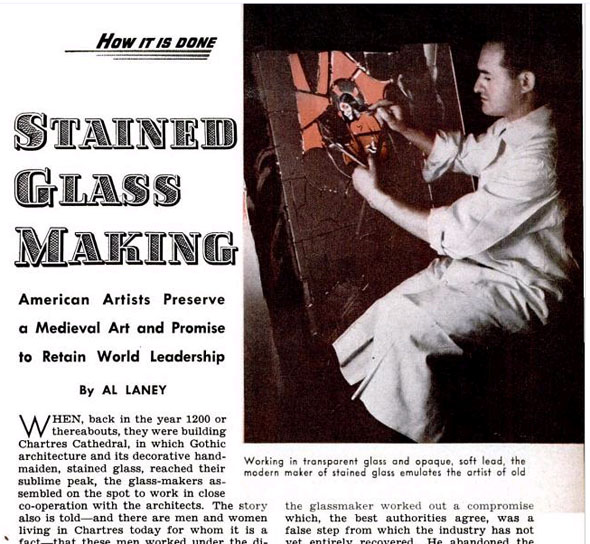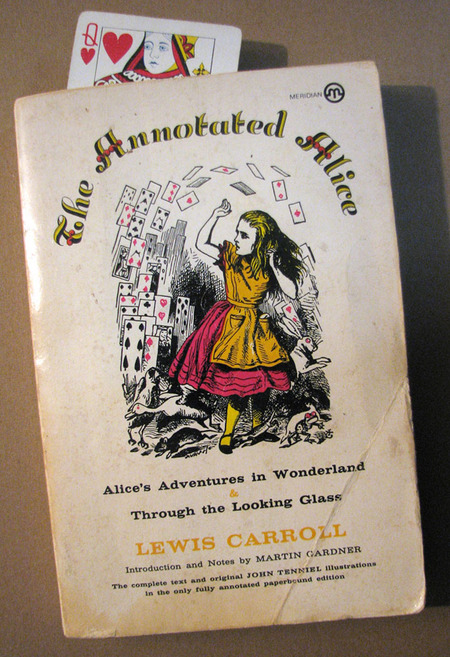March 31, 2010
Happy 175th, John La Farge
John La Farge, born 175 years ago today, on March 31, 1835, is best known in the realm of American opalescent stained glass history.
One thing I like about La Farge's stained glass work, despite the relatively traditional graphic style, is the experimental approach to the process of making stained glass windows. It is a point that is rarely emphasized in accounts of his work.
In honor of his birthday, I'll show just one example.
Peonies in the Wind, watercolor by John La Farge
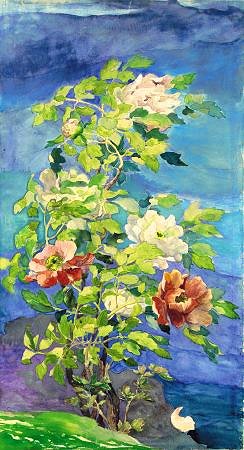
La Farge made a number of variations of this design in stained glass, and they all feature different approaches to the design, experimenting with different processes, especially in creating the peonies themselves.
A painted version of the peony. It's actually quite rare to see painted pieces in La Farge's floral areas.
click to enlarge
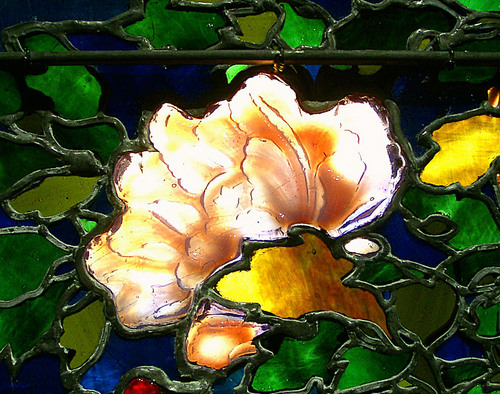
This version in St. Louis features pressed or molded glass.
click to enlarge

MFA, Boston - another pressed glass version
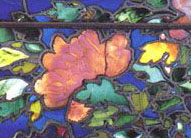
Constructed, mosaic style
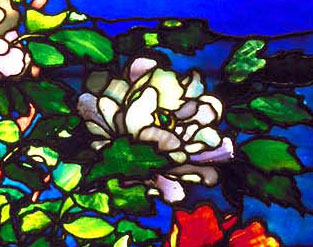
Smithsonian American Art Museum
March 18, 2010
Nina Paley, Copyleftist
As a preview of my epic, long-in-the-making-but-not-posted-yet blogpost on copyright issues, I give a fun preview of the concept of the "copyleftist" - a 'minute meme' from questioncopyright.org.
All Creative Work is Derivative -
Read about the process and ideas behind All Creative Work is Derivative (scroll down past the video).
Nina Paley is a cartoonist and animator who made a feature length animated film called Sita Sings the Blues, which ran into copyright infringement issues. Her reaction was not to pay hundreds of thousands of dollars to free it up for traditional distribution, but to let it be open and free to the public at large.
So, carve out the time and go see Sita Sings the Blues (81 minutes). It's free for the viewing, or downloading, and it's good, too.
I can't pretend that I understand yet how she makes money with the Sita Distributtion Model, but I find the whole idea intriguing and I certainly have an open mind on the subject.
March 17, 2010
Sigmar Polke at Grossmünster
A recent blog post from P.M. Doolan's ThinkShop about Sigmar Polke's Stained Glass Windows, with several images. I'd heard of these windows from the 2008 New Yorker article Many-Colored Glass, but the windows were not complete at that time.
This is an all-agate slice window, one of several by Polke in the church. I still haven't seen any decent shots of the windows in an architectural setting.
click to see larger image in new window
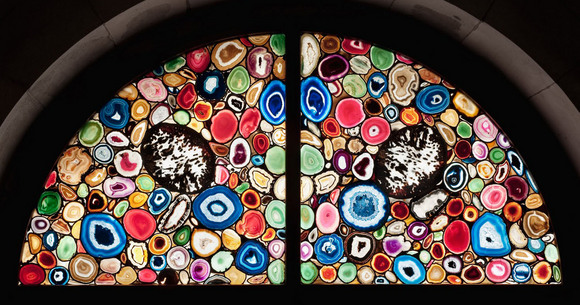
photo from a press kit released by the Grossmünster
This same window was pictured, while still on the bench in process, as part of the slideshow for the New Yorker article. It's interesting to see the contrast, and to see some of the other agate windows in the background finished but in the studio, pre-installation.
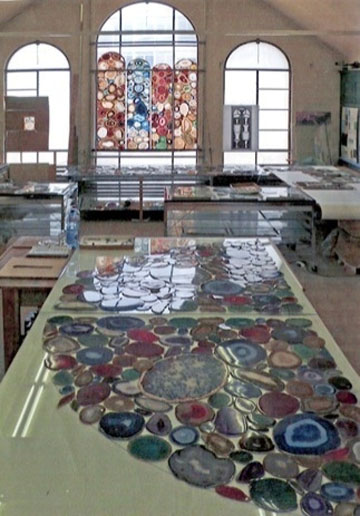
PHOTOGRAPH: Urs Rickenbach, Glas Mäder & Co., Zürich
Read more: New Yorker Slideshow
A detail
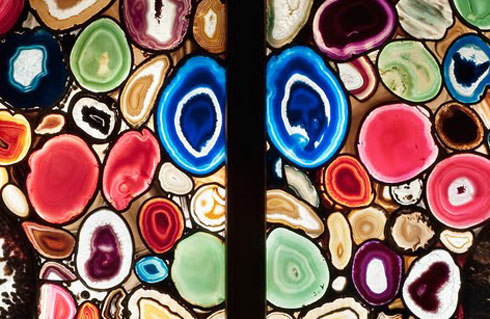 .
.
One question I have about this window is a technical one. Most of the agate slices made for trade, especially the ones with bright and deeply saturated blues and pinks, are dyed with aniline dyes, and are not lightfast. That is, the colors will fade or change color over prolonged exposure to sunlight. I can only assume that the makers of this window know this and stayed away from the artificially dyed agate. I don't know enough about it to tell from the photographs alone. Time will tell.
When I first mentioned the New Yorker article in a blog post in May of 2008, I referred to it as "maddening". It's nearly 2 years later and I stick by that assessment. Why? To start with, Peter Schjeldahl's prose style can be pretty tortured. While I may well agree with some of his assertions, most are written in so roundabout a manner that I can't tell if I agree or not. It comes off as little more than art critical blathering.
One example -
The literally paradoxical, if not quite heretical, results of these two projects pose a question of whether, in Christian Europe today, art on celebrated artists’ terms has risen to equality with religion or if religion has sunk to the level of mere art.
I can't quite tell what is more convoluted here, the idea that is being presented or the prose style that is presenting it. Mostly, I still feel as I did in 2008, that it's not even worth my time to try to do a point by point rebuttal of those things I disagree with, since the general air of the article is one of condescension - that the New Yorker would not even be covering such an art form ("if it is an art form", says Schjeldahl), if the two leading painters of the day were not currently involved in these stained glass projects. Why bother?
March 12, 2010
Andy Young on Southern Expressions
An interview with Mississipi based stained glass artist Andy Young. Andy and I were both in a group gallery show called "The Glass Canvas", in Boston, way back in 1993, before either of us had any grey hair.
13:30 long
He talks in the video (from around 7:30 to 9:00) about a set of windows he did for a chapel in a Retirement Village in Asheville, North Carolina. I should note that the American Glass Guild will be having their 2011 conference in Asheville, and there is a strong likelihood that these windows will be a part of the bus tour.
March 08, 2010
Popular Science - Stained Glass Making
The entire run of Popular Science is now available for viewing through Google books. Not much on stained glass, but there is this article. How it is Done: Stained Glass Making, October 1942
Unfortunately, the article does not name any of the people in the photos, and only mentions the name of the studio once, toward the end of the article. It's Rambusch Decorating Company, which is still around today, in New York City. The article is a bit of an oddity in this issue, seeing that this was 1942 and most of the articles are related to the war.
March 07, 2010
AGGnews v1.1
If you've been wondering why I've not been doing as much blogging recently, this is the reason. The first issue of AGGnews, the new Quarterly eNewsletter for the American Glass Guild. I did all the design and layout, with some minor editing of the text.
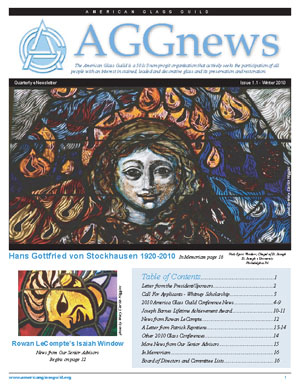
Download the full 16 page pdf here, it's 1.2 mb big.
You can see a page from how the email campaign looked, in this case to prospective new members.
Much of the issue deals with the 2010 American Glass Guild Conference, taking place in Detroit in July. I'm doing a pre-conference workshop, with Dan Maher, on Photo Transfer Techniques. I'm also going to be moderating a panel on the impact of Photoshop on the world of stained glass design.
March 06, 2010
Artist Brian Clarke talks about Glass and Light
This is short, less than 2 minutes, but interesting. I'd never seen an interview with Brian Clarke before and so it's interesting to see him and hear his words.
Brian Clarke is one of those big name stained glass artists whose work I've heard of for a long time and seen lots of pictures of, but have mixed feelings about. He does mostly large-scale abstract works for secular spaces. That's all well and good, but the images I've seen all seem a bit dull and corporate to me. Still, I'm keeping an open mind until I see an actual work of his. I tried, about 2 years ago, as I was driving through Connecticut, to see his Stamford Cone, located at the headquarters building of the Swiss Banking Corporation, but I couldn't find it. I even asked several locals for directions but none of them had heard of it. Some day.
Guess I should've checked Google Maps more carefully. or Google Street View
March 05, 2010
Argentinian Bottle House
Contemporary Bottle House Creator, said to have 6 million bottles involved?! The stained glassy shots don't start until about 1:35 into the 2:39 video.
March 04, 2010
Mad Tea Parties Compared
Since my most popular blog post remains the one on the Alice Windows in Daresbury, and there is a big new movie version of Alice in Wonderland coming out tomorrow, I'd thought I'd look at some comparative takes on the Mad Tea Party scene. Here is the original text for The Mad Tea-Party, with the Tenniel illustrations.
I'm putting the scenes in no particular order. Starting with the 1966 version directed by Jonathan Miller. Even though this is one of the weirdest, and least "Tenniel-based" of the adaptations, it is also one of the most true to the words and structure of the scene. I'm a sucker for great British character actors, and this is loaded with them. Peter Cook's trippy and mesmerizing version of the Mad Hatter is memorable.
Seven more variations of the scene below the fold...
Meryl Streep in a musical version of Alice - huh?
1983 TV sersion with Kate Burton as Alice and Andre Gregory as the Mad Hatter
a version from 1985 with some pretty strange casting choices (Telly Savalas as the Cheshire cat?!) including Anthony Newley as the Mad Hatter and and Roddy Macdowell as the March Hare. This is notable as one of the few live action versions that actually casts a real child as Alice, rather than a teenager or adult as Alice.
The 1952 Disney version. Being a Disney version, it is the one least like the Carroll original. Ed Wynn did the voice for the Mad Hatter, and Jerry Cologna for the March Hare.
1933 Hollywood version with Edward Everett Horton as the Mad Hatter
only found it over 2 sections
starts at 7:25
then the first 2 minutes of this part
if those disappear, there is this crude recorded version as well, that at least give a sense of the general approach.
this is from Dreamchild, from 1985,
written by Dennis Potter, of 'Singing Detective' Fame.
Bad video but gives the sense of the treatment of the scene
a much darker treatment it is, too
Jim Henson's workshop did the puppetry
Peter Sellers as the March Hare and Dudley Moore as the Dormouse
with weird musical outbreaks
Curiously, this is the second version of Alice in Wonderland to have Peter Sellers in the cast. He was the King of Hearts in the 1966 Jonathan Miller version.
1999 version. Computer graphics have crept into the mix with the CGI oversized heads. Martins Short as the Mad Hatter. This is another lousy recording but the only one I could find embedded.
I also could not find the whole thing in one place. There is a not terribly good or funny song and dance number right after this. Auntie's Wooden Leg, from the 1999 version of Alice in Wonderland.
And, of course - Why is a Raven like a Writing Desk?
Carroll refused to answer for a long time, but eventually came up with this - Both produce flat notes, neither of them musical
some other have suggested -
Edgar Allen Poe both wrote on one.
and finally, just to prove my long time Alice creds, here is a picture of my 25 year old well worn copy of the essential guide to Alice, The Annotated Alice by Martin Gardner. Along with appropriate bookmark.
